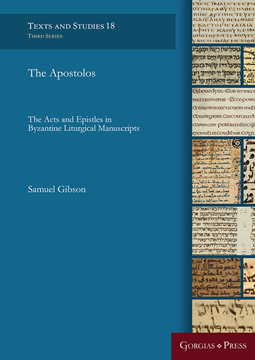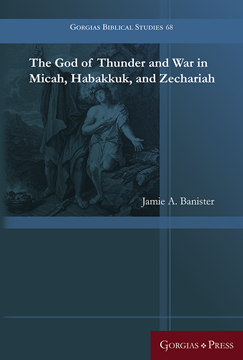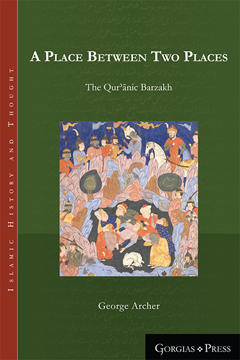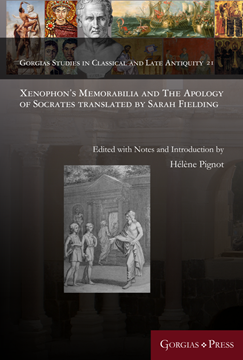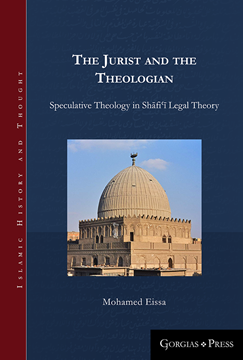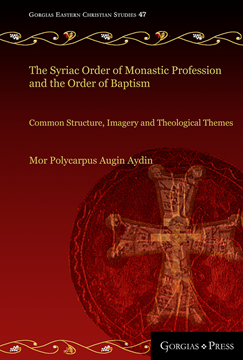The Apostolos
The Acts and Epistles in Byzantine Liturgical Manuscripts
Series: Texts and Studies (Third Series) 18
ISBN: 978-1-4632-0609-3
Lectionary studies were almost abandoned after the mid-twentieth century, and the recent revival of interest in the Greek Lectionary has concentrated exclusively on the Gospel Lectionary. Gibson reintroduces the value of the Apostolos yet incorporates modern methodology in order to build upon the work of recent Lectionary scholarship, analysing New Testament and liturgical textual traditions together, both compilation and continuous text. Through this process, it is shown that the Apostolos witness is not usually copied to another and that consequently there is no ‘Lectionary text’ of Acts and Paul. Instead, Apostolos copies reflect textual variation in the evolving Byzantine tradition. This study concentrates on the Apostolos in its scribal, monastic, liturgical, and theological context as well as in light of other manuscript traditions.
$166.00 (USD) $99.60 (USD)
Conceptualizing Distress in the Psalms
A Form-Critical and Cognitive Semantic Study of the צרר1 Word Group
Series: Gorgias Biblical Studies 66
ISBN: 978-1-4632-0610-9
Psalms containing lexemes derived from the Hebrew root צרר (to bind, be in distress) reveal a previously-unnoticed generic subgroup in the Psalter. Through structural and cognitive linguistic principles, Rasmussen explores issues related to genre, Hebrew grammar, and syntax in order to arrive at a set of three cognitive domains of “powerlessness,” “palpable threat,” and “entreaty” which are relatively unique to psalms that include צרר lexemes. Rasmussen also makes suggestions about the editorial process of the Hebrew Psalter, concluding that after the Babylonian exile, distress was more strongly associated with divine discipline and displeasure, whereas before the exile it was more associated with declarations of innocence.
$114.95 (USD) $68.97 (USD)
The God of Thunder and War in Micah, Habakkuk, and Zechariah
Series: Gorgias Biblical Studies 68
ISBN: 978-1-4632-0611-6
This volume explores storm-/warrior-god motif as found in non-biblical ANE texts, followed by an analysis of the language and imagery in several noteworthy theophanic passages in the Hebrew Bible. These characteristics and vocabulary are used in later chapters to identify and analyze similar motifs in the Twelve Prophets, especially focusing on Mic 7:7-20; Habakkuk 3; and Zech 9:9-16 as test cases. By tracing the use of the storm-/warrior-god motif and language associated with it, a detectable shift is apparent in the use of the motif in the HB that corresponds with the development of monotheism within Ancient Israelite religion.
$114.95 (USD) $68.97 (USD)
A Place Between Two Places
The Quranic Barzakh
Series: Islamic History and Thought 1
ISBN: 978-1-4632-0612-3
For believers in a resurrection of the body, there arises the question of what happens after death but before the Last Day: the intermediate state. For most Muslims, the intermediate state is the barzakh. It is a fantastical and frightening time in the grave. The present study will examine where the belief in the barzakh comes from through a study of the Qur'an.
$129.00 (USD) $77.40 (USD)
Xenophon's Memorabilia and The Apology of Socrates translated by Sarah Fielding
Edited with Notes and Introduction by Hélène Pignot
ISBN: 978-1-4632-0614-7
Sarah Fielding (1710-1768), the younger sister of Henry Fielding, and the close friend of his literary rival Samuel Richardson, was one of the very few English women to master ancient languages like Latin and Greek. With the help of Shaftesbury's nephew, James Harris, a distinguished writer, scholar and grammarian, she embarked on the ambitious project of translating Xenophon's Memorabilia and the Apology of Socrates from the Greek. This work, titled Memoirs of Socrates, with the Defence of Socrates before his Judges, was finally released in 1762. She proved a discreet editor and a talented Hellenist, whose elegant style garnered praise from Tobias Smollett in his Critical Review. This superb translation is re-published in its entirety for the first time since the 18th century.
$141.00 (USD) $84.60 (USD)
Jacob of Sarug’s Homilies on the Six Days of Creation (The Third Day)
The Third Day
Edited and Translated by Edward G Mathews Jr
Series: Texts from Christian Late Antiquity 47
ISBN: 978-1-4632-0615-4
In this third part of Homily 71, On the Fashioning of Creation, Jacob treats the God's separation of the waters from the earth, and the bringing forth of vegetation on the newly-revealed dry land.
$32.00 (USD) $19.20 (USD)
The Last Empire of Iran
Series: Gorgias Handbooks 44
ISBN: 978-1-4632-0616-1
As part of the Gorgias Handbook Series, this book provides a political and military history of the Sasanian Empire in Late Antiquity (220s to 651 CE). The book takes the form of a narrative, which situates Sasanian Iran as a continental power between Rome and the world of the steppe nomad.
$90.00 (USD) $54.00 (USD)
The Jurist and the Theologian
Speculative Theology in Shāfiʿī Legal Theory
Series: Islamic History and Thought 5
ISBN: 978-1-4632-0618-5
This in-depth study examines the relation between legal theory (uṣūl al-fiqh) and speculative theology (ʿīlm al-kalām). It compares the legal theory of four classical jurists who belonged to the same school of law, the Shāfiʿī school, yet followed three different theological traditions. The aim of this comparison is to understand to what extent, and in what way, the theology of each jurist shaped his choices in legal theory.
$176.00 (USD) $105.60 (USD)
The Syriac Order of Monastic Profession and the Order of Baptism
Common Structure, Imagery and Theological Themes
Series: Gorgias Eastern Christian Studies 47
ISBN: 978-1-4632-0619-2
Is monastic profession in the West-Syriac tradition a “second baptism”? A relationship clearly exists between the two rites of initiation in the West-Syriac tradition: the monastic profession and baptism. Aydin examines these two rites of initiation, comparing their external structures, common imagery and theological themes, and reveals that the monastic rite closely parallels, or even is modeled upon, that of baptism. Mor Polycarpus Edip Aydin explores the idea of monastic profession as a “second baptism,” or rather, the realization of what the gift of the Spirit at baptism really implies. An extensive Appendix contains Syriac texts with English translations pertaining to the Syriac rite of monastic profession, with relevant commentaries by Syriac Fathers from the 6th to the 10th centuries.
$128.00 (USD) $76.80 (USD)
Manchester Journal of Jewish Studies (2015)
Atheism, Scepticism and Challenges to Monotheism
Edited by Daniel R. Langton
ISBN: 978-1-4632-0622-2
Volume 12 of Melilah, an interdisciplinary electronic journal concerned with Jewish law, history, literature, religion, culture and thought in the ancient, medieval and modern eras.
$68.00 (USD) $40.80 (USD)
